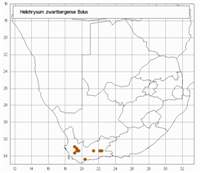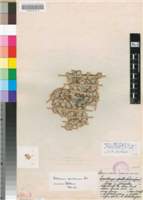Origin of name:
zwartbergense = from the Swartberg
Diagnostic characters:
Mat-formingWhite wooly plantReddish brown bracts, obtuse and then emarginated with age
Description:
Grey-woolly herb, probably perennial, woody at the root, stems many from the crown, 40-150 mm long, prostrate, profusely branched, forming dense little mats, branchlets slender, white-woolly, closely leafy. Leaves 3-8 (-15) x 1.5-5 (-7) mm, spathulate, obovate or subrotund, tips rounded, base somewhat narrowed, half-clasping, both surfaces densely greyish-white woolly. Heads homogamous, or very rarely one flower female, cylindric, c. 5 x 3 mm, solitary or several clustered at the tips of the branchlets, surrounded by leaves. Involucral bracts in 4 series, soon caducous, outer 2 series shorter, webbed with wool to 3-4 reduced surrounding leaves, inner series subequal, about equaling flowers, not radiating, all light golden-brown, sometimes red above the stereome, semi-pellucid, extreme tip opaque, straw-coloured, obtuse and then usually emarginate, or sometimes subacute to shortly acuminate. Receptacle nearly smooth. Flowers 15-44. Achenes 1 mm, glabrous or hairy and then myxogenic. Pappus bristles very many, in more than 1 series, equaling corolla, delicate, scabrid, bases cohering by patent cilia.
Flowers mainly in December and January.
Distribution:
On the high mountains of the Western Cape, from the Cedarberg near Clanwilliam to the Tsitsikama Mountains, Uniondale district, and Cockscomb in the Great Winterhoek Mountains, Uitenhage district, generally between 1 200 and 2 200 m above sea level.
Fynbos Biome.
Notes:
H. zwartbergense is characterized by its caespitose habit and mostly obtuse involucral bracts. However, the bract tips may be acute or shortly acuminate. The obtuse tips are themselves interesting: many are bidentate, and look exactly as though they had been nipped off. It seems likely that only a small and easily varied genetic factor is responsible for the degree of development of the tips.
It may well be that H. zwartbergense is only a high altitude, more compact, form of H. tinctum; there is certainly no clearcut distinction between them, either in growth habit or in degree of development of the bract tips. However, over most of its range, H. zwartbergense is easily recognized; difficulty arises in the mountains between Wellington, Ceres and Worcester. A number of collections made over the years by Miss Esterhuysen are particularly interesting and point the need for further study in the field.
Taxonomy:
Literature:
Helichrysum zwartbergense H. Bol. in Trans. S. Afr. phil. Soc. 18: 382 (1907).
Type:
Western Cape, Prince Albert distr., rocky places on summit of Zwartberg range, c. 5 500 ft, Dec. 1904, Bolus 11532 (BOL, holo.; BM; K, iso.).
Synonym(s):
Vouchers:
Compton 12852 (NBG); Esterhuysen 134491 (BOL; PRE); Lewis 1118 (SAM); Stokoe in SAM 51421 (PRE).
_sml.jpg)
_sml.jpg)
_sml.jpg)
_sml.jpg)
_sml.jpg)
